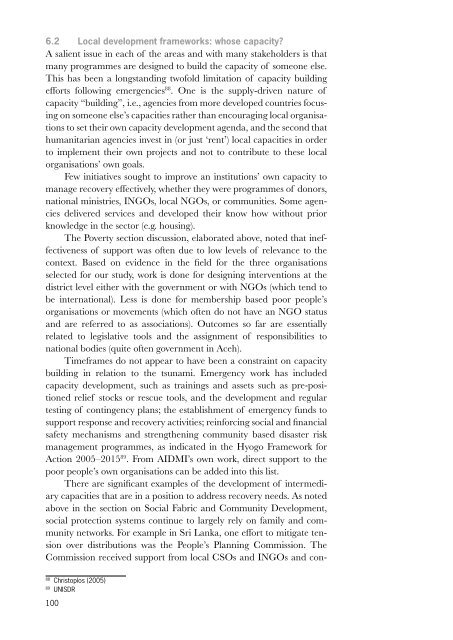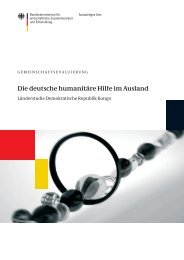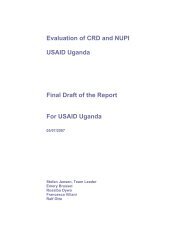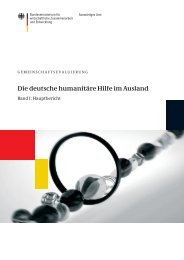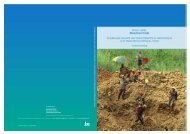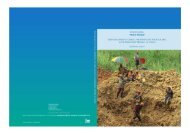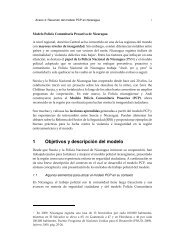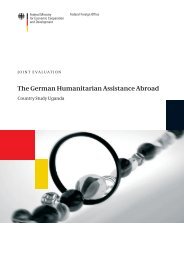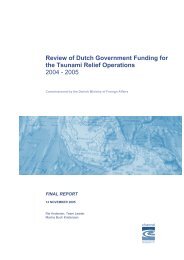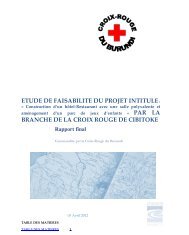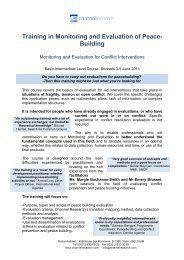A ripple in development? - Channel Research
A ripple in development? - Channel Research
A ripple in development? - Channel Research
Create successful ePaper yourself
Turn your PDF publications into a flip-book with our unique Google optimized e-Paper software.
6.2 Local <strong>development</strong> frameworks: whose capacity?<br />
A salient issue <strong>in</strong> each of the areas and with many stakeholders is that<br />
many programmes are designed to build the capacity of someone else.<br />
This has been a longstand<strong>in</strong>g twofold limitation of capacity build<strong>in</strong>g<br />
efforts follow<strong>in</strong>g emergencies 88 . One is the supply-driven nature of<br />
capacity “build<strong>in</strong>g”, i.e., agencies from more developed countries focus<strong>in</strong>g<br />
on someone else’s capacities rather than encourag<strong>in</strong>g local organisations<br />
to set their own capacity <strong>development</strong> agenda, and the second that<br />
humanitarian agencies <strong>in</strong>vest <strong>in</strong> (or just ‘rent’) local capacities <strong>in</strong> order<br />
to implement their own projects and not to contribute to these local<br />
organisations’ own goals.<br />
Few <strong>in</strong>itiatives sought to improve an <strong>in</strong>stitutions’ own capacity to<br />
manage recovery effectively, whether they were programmes of donors,<br />
national m<strong>in</strong>istries, INGOs, local NGOs, or communities. Some agencies<br />
delivered services and developed their know how without prior<br />
knowledge <strong>in</strong> the sector (e.g. hous<strong>in</strong>g).<br />
The Poverty section discussion, elaborated above, noted that <strong>in</strong>effectiveness<br />
of support was often due to low levels of relevance to the<br />
context. Based on evidence <strong>in</strong> the field for the three organisations<br />
selected for our study, work is done for design<strong>in</strong>g <strong>in</strong>terventions at the<br />
district level either with the government or with NGOs (which tend to<br />
be <strong>in</strong>ternational). Less is done for membership based poor people’s<br />
organisations or movements (which often do not have an NGO status<br />
and are referred to as associations). Outcomes so far are essentially<br />
related to legislative tools and the assignment of responsibilities to<br />
national bodies (quite often government <strong>in</strong> Aceh).<br />
Timeframes do not appear to have been a constra<strong>in</strong>t on capacity<br />
build<strong>in</strong>g <strong>in</strong> relation to the tsunami. Emergency work has <strong>in</strong>cluded<br />
capacity <strong>development</strong>, such as tra<strong>in</strong><strong>in</strong>gs and assets such as pre-positioned<br />
relief stocks or rescue tools, and the <strong>development</strong> and regular<br />
test<strong>in</strong>g of cont<strong>in</strong>gency plans; the establishment of emergency funds to<br />
support response and recovery activities; re<strong>in</strong>forc<strong>in</strong>g social and f<strong>in</strong>ancial<br />
safety mechanisms and strengthen<strong>in</strong>g community based disaster risk<br />
management programmes, as <strong>in</strong>dicated <strong>in</strong> the Hyogo Framework for<br />
Action 2005–2015 89 . From AIDMI’s own work, direct support to the<br />
poor people’s own organisations can be added <strong>in</strong>to this list.<br />
There are significant examples of the <strong>development</strong> of <strong>in</strong>termediary<br />
capacities that are <strong>in</strong> a position to address recovery needs. As noted<br />
above <strong>in</strong> the section on Social Fabric and Community Development,<br />
social protection systems cont<strong>in</strong>ue to largely rely on family and community<br />
networks. For example <strong>in</strong> Sri Lanka, one effort to mitigate tension<br />
over distributions was the People’s Plann<strong>in</strong>g Commission. The<br />
Commission received support from local CSOs and INGOs and con-<br />
88<br />
Christoplos (2005)<br />
89<br />
UNISDR<br />
100


